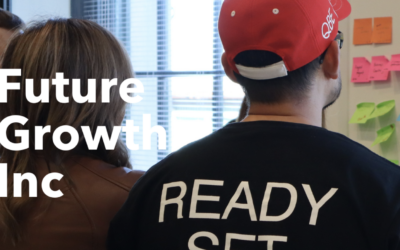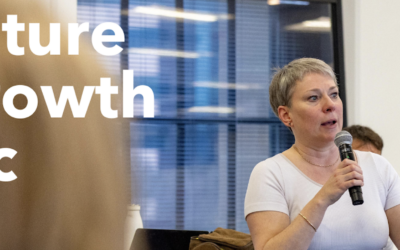The modern language of innovation is peppered with teamwork and empathy. We talk of small, agile teams that collaborate. We talk of user centred journeys. User stories. User centred design. And more. We focus our processes around validating our business models with real customers (not just members of our team who have checked our pitch deck). And we reinforce all this with the power of chaos and confusion – that element of not-knowing the answer to a challenging problem – yet working our way to a solution.
Despite all the books about “lean” and “agile” that can be found on Amazon – or the handbooks that we ourselves write, or processes and workshop guides that we produce, getting close to your customers remains a profoundly sticky challenge. It is human. Confronting. But can also be exhilarating.
Often, when we are presented with a challenge, we jump to a solution. We do so because the sense of “not knowing” makes us uncomfortable. Or we want to demonstrate our expertise, know-how or insight. We want to master the problem.
However, what this does is make the problem about us, not about the people who experience it. We (as the “problem solvers”) gloss over the problem without exploring its nuances – we are seeing the problem only from the point of view of the solution and what we can do, not the lives of those who experience the problem and its manifestations. Recently, we supported Vibewire’s Hack for Homelessness – a two day hackathon that tackled the social, technical, cultural and behavioural challenges of homelessness. It was eye opening and confronting.
So how do we approach these kind of challenges in a different way? If you have been involved in a design thinking exercise, no doubt you will have heard the phrase “look through the eyes of your customer”. It sounds like the theme from an episode of Utopia, but it is an important element in creating meaningful business solutions that resonate with your customers. It also allows you, as a problem solver, to tackle the root causes of the issue, not the most easily identifiable symptoms. We call this finding the Problem Worth Solving.
To pursue the problem worth solving, we need to exercise empathy. We have to do so consciously and we have to do so by withholding judgement. We have to get comfortable with our own sense of uncomfortableness.
Getting comfortable feeling uncomfortable
When working with our clients on an innovation program, we often find the Discovery phase the most confronting. It is our job to take teams out of their comfort zone – and into a space where they are no longer in control, or have the mastery that marks every aspect of their professional life. Some people greet this discomfort with grace and curiosity. Some people rebel against it. The thing to remember, is that empathy is like a muscle – the more you exercise it, the better you get at it. And empathy can be a decisive, strategic enabler of any innovation program because it truly means you can put your customer/stakeholder first.
During some recent work with Siemens, we had workshopped a large number of teams to build their digital transformation capabilities. The two day program was intense, fast moving and highly immersive. There was no place to hide – it was 100% participation. Towards the end of Day 2, one of the participants said to me, “I get it. We’re getting used to being comfortable feeling uncomfortable”. He had realised that the discomfort was producing outstanding outcomes for himself and his team – but that the discomfort had to be worked through. Empathy was doing its job.
So what does it mean to exercise empathy?
Author Brene Brown explains that, as humans, we are wired to run from pain – whether it is ours or someone else’s. So exposing ourselves to discomfort triggers deep seated anxieties and responses. She explains that when we feel heard, we feel cared about and understood – and that means that an empathic response to a problem can trump a solution to that problem.
One of the strengths of design thinking is that it provides a framework in which we can be exposed to different ways of understanding problems – hopefully without triggering these anxiousness-inducing responses. And in purposefully extending this approach to developing solutions, business models and outcomes, this empathic approach can give us a path to a deeper understanding of the issues from a personal, professional, financial and social perspective. It simply allows us to delve deeper. The key, Brene Brown suggests, is “perspective taking”.
In working with Vibewire’s Hack for Homelessness, we needed to make some changes to the way that we run, structure and deliver our hackathons. Some of the changes were easy – for example, we could use our Shared Value Canvas to help model out the social enterprise business models of each of the teams. Other changes were more difficult. For example, we worked with people who had lived and current experience of homelessness – they shared their stories, mentored teams and even judged the pitches. They were fearless in their understanding and questioning – with more pointed questions than a dozen entrepreneurial Steve Baxters on an episode of Shark Tank.
But like almost every hackathon event that we run, we also learn a great deal. And our debrief delivered important lessons for our continuous improvement program. When it comes to innovation – whether that innovation is tech, social, cultural or professional in nature – it was clear that we needed to be more structured in our process for exercising empathy through the four dimensions of perspective taking:
- Believing people’s stories when they tell them. Part of an agile innovation cycle is storytelling – specifically – “user stories”. The importance of taking those stories at face value cannot be underestimated. In fact, believing these stories is step one – we leave validation and context for later in the process.
- Suspending judgement. As mentioned above, jumping to a “solving” mindset moves us very quickly away from understanding the landscape of the problem worth solving. We need to actively work to suspend our judgement so that we can be open to new ways of co-creating or co-designing the solution.
- Recognising emotion. When we recognise the pain experienced by our customers – the challenge, the discomfort and so on – we recognise something within our own selves. By listening to the stories of others, we are acknowledging the truth of their situation.When we feel discomfort, try to name the emotion – ask yourself what you are feeling and why is that feeling being triggered?
- Playing back emotion. To acknowledge and communicate your understanding, it’s important to play back what you have heard. That doesn’t mean restating facts, but communicating the emotion of the challenge in your own words.
But this feels like more than “just innovation” …
If you are wondering whether these principles can be applied to other challenges, then of course, the answer is “yes”. These principles help us understand our own responses and the responses of others in the face of change, chaos and disruption. In fact, many social innovators use these same techniques to uncover and understand large scale, intractable problems that occur in society at large.
To see how the Vibewire Hack for Homelessness program finished up, take a look at the final report. Amazingly, the teams that were created, remain working on their idea and are committed to making a substantial impact on the challenges of homelessness.
The question for you, is how and where will you test it out? How will you take an empathic approach to your next business challenge? And will you be courageous enough to not just “jump” to a solution?



